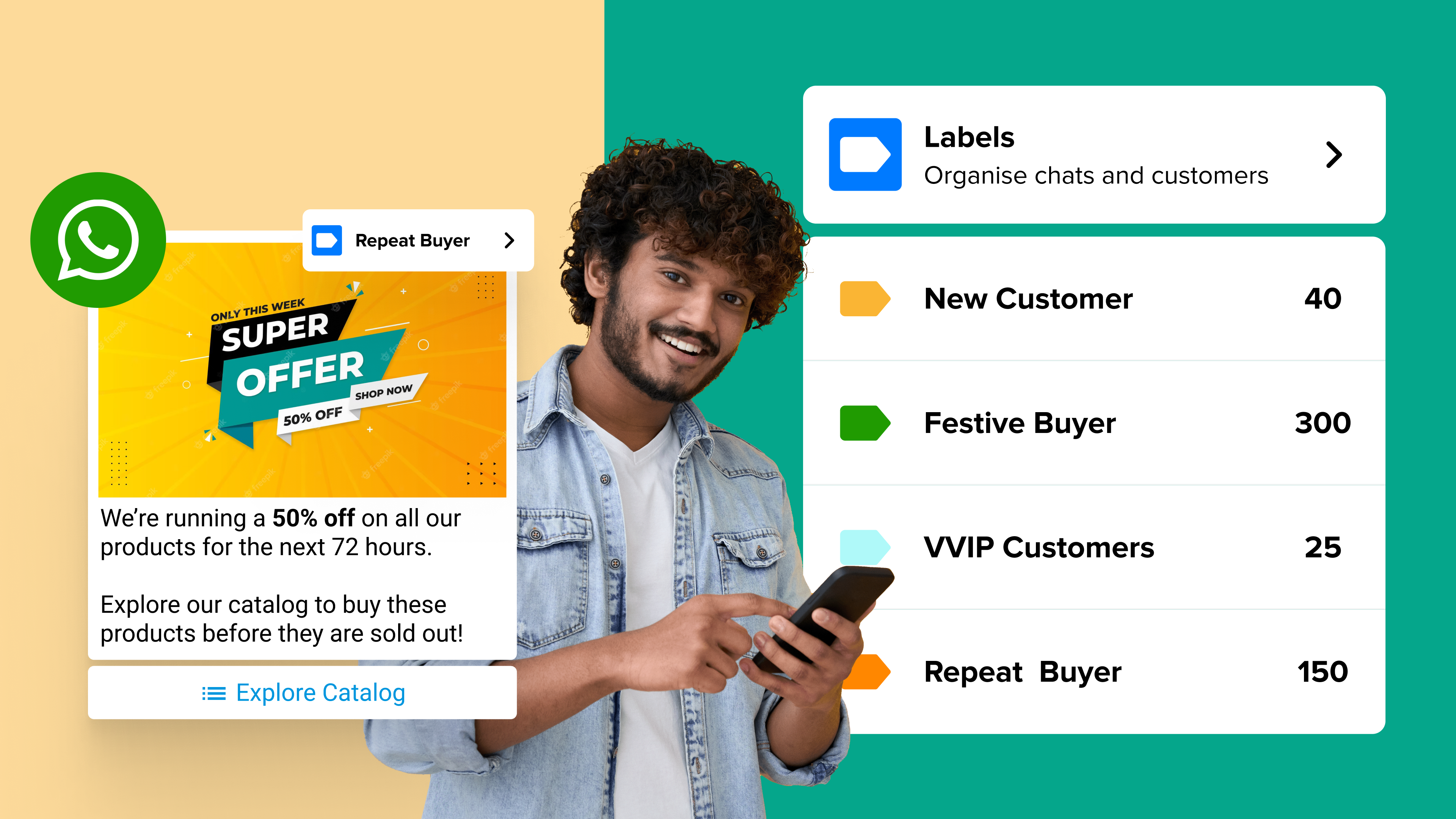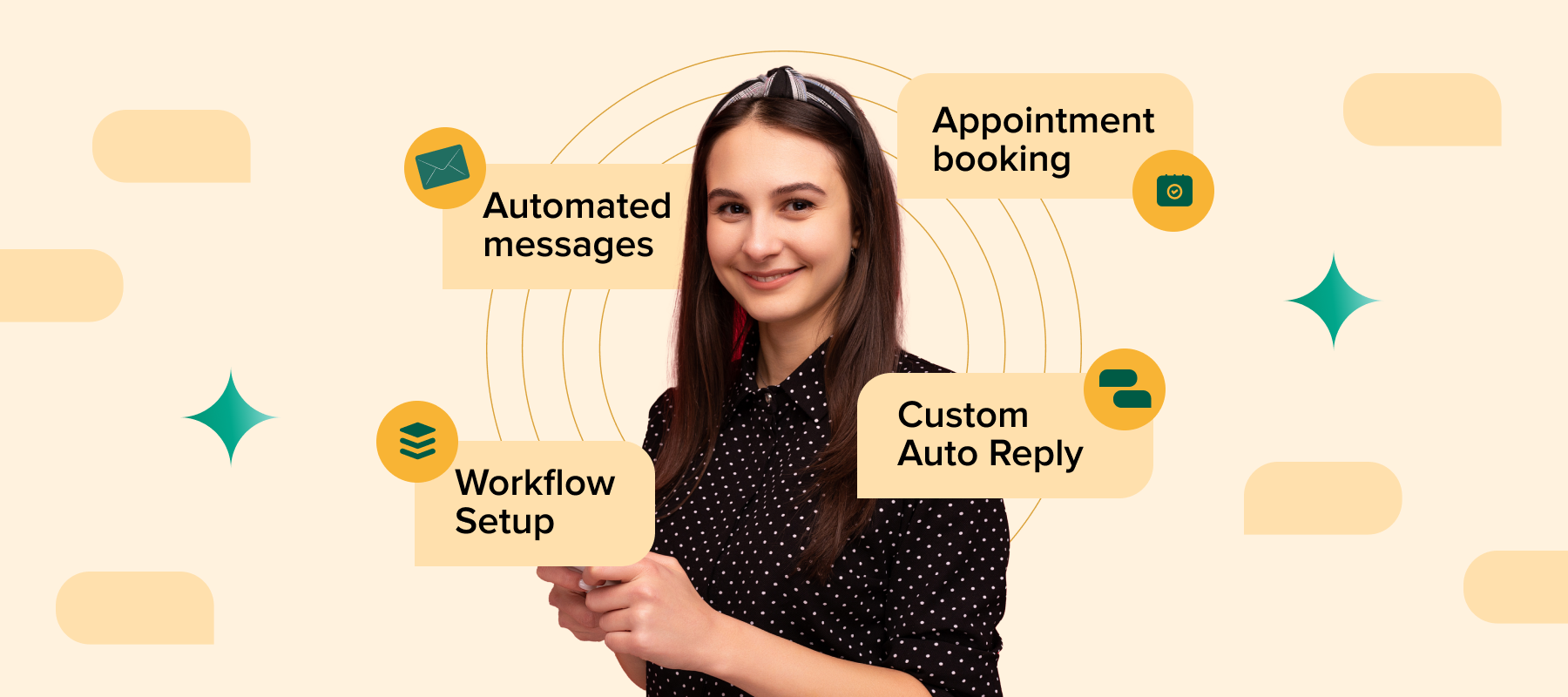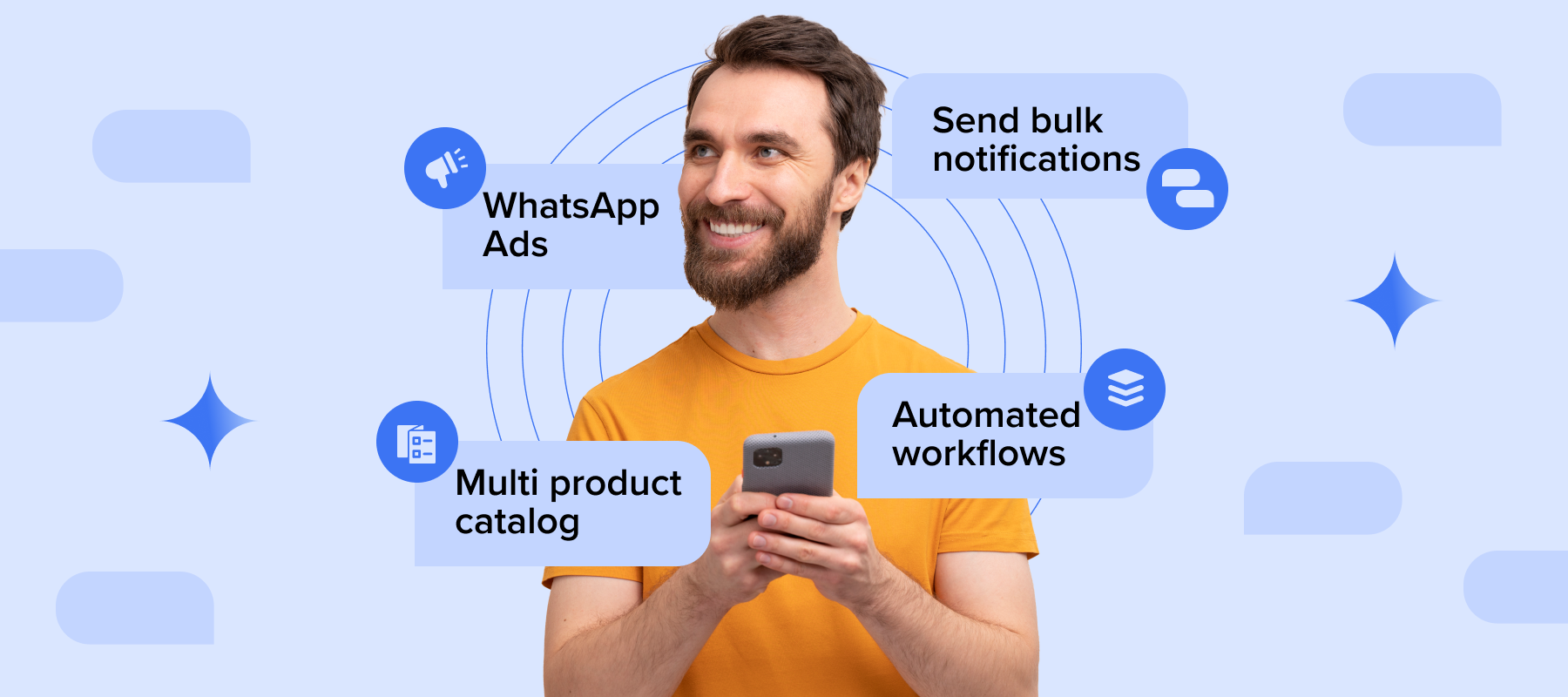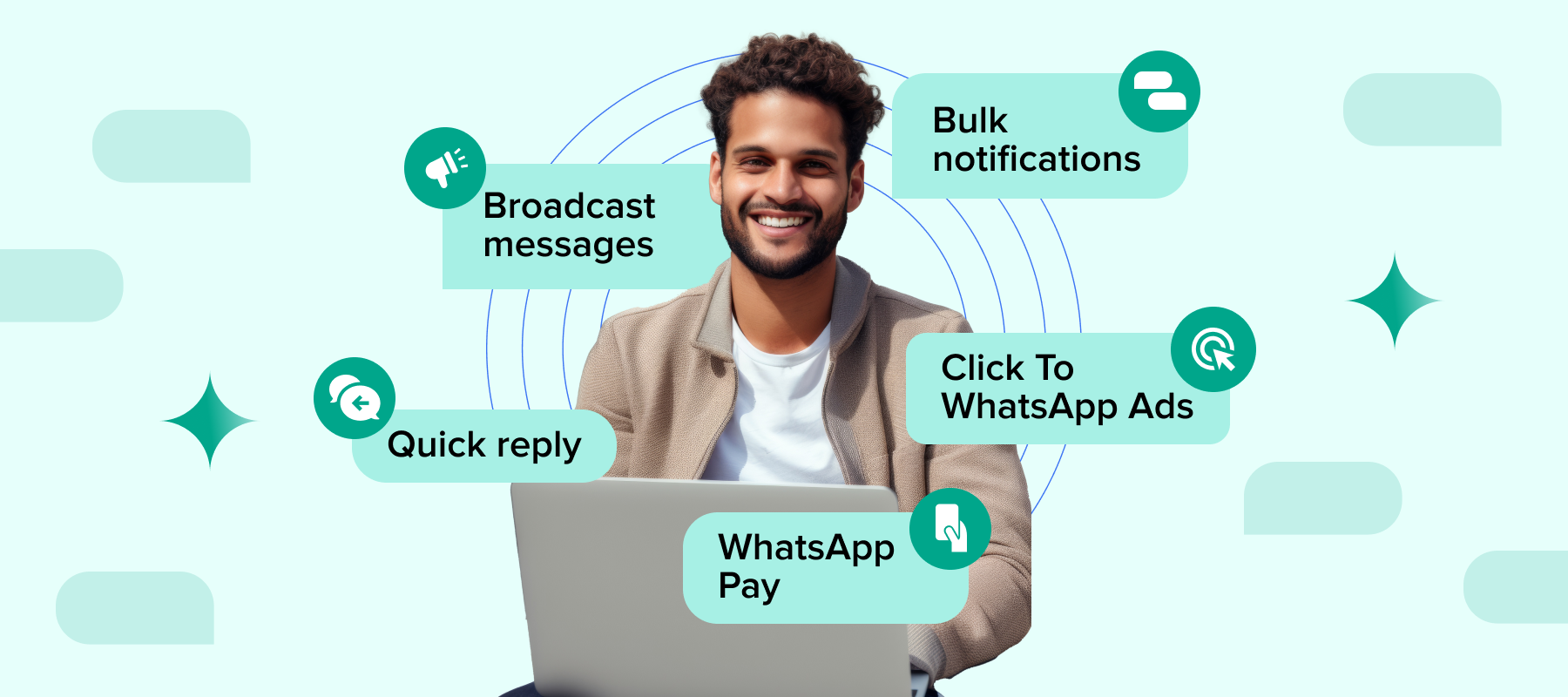WhatsApp has become a go-to channel for businesses to run marketing campaigns on. But as the competition for consumer attention increases on the messaging platform as well, it’s the effort that businesses put into personalization that can yield the desired results from campaigns. And that’s where WhatsApp customer segmentation comes in.
In this post, we’re going to walk you through what customer segmentation on WhatsApp is, its benefits, the different types and how you can put these customer segments to use.
What is customer segmentation?
Customer segmentation refers to the process of grouping subscribers or customers in your WhatsApp list into distinct groups. These groups are created based on common criteria like age, gender, purchase preferences, spend capacity, location, engagement rate and other parameters.
For example, a business that sells products to both men and women can have two clear segments to promote relevant products to each. Similarly, a brand selling both high-end and affordable products can create segments based on the average purchase value of buyers to ensure they reach out with the right set of product recommendations in WhatsApp marketing campaigns.
What are the benefits of WhatsApp customer segmentation?
Just like how you create customer segments for marketing on channels like emails and SMS, here are the benefits of doing so on WhatsApp:
1. Better personalization and targeting
Generic WhatsApp broadcast campaigns are like mass messages that people ignore. With customer segmentation, you can identify the types of customers your business has and what they would prefer hearing about or purchasing from you. Customer segmentation helps businesses with better personalization for targeting the right set of customers with the right message.
2. Reduced WhatsApp opt-outs
With more and more businesses using WhatsApp to run promotions, consumers are feeling spammed and actively opting out of lists. When you use customer segmentation on WhatsApp, you ensure relevancy of messages to the recipients and that reduces the chances of them opting out of your list as they see more value coming from you.
3. Increased customer engagement
Now that your WhatsApp Marketing campaigns are more contextual to the consumers, they become more likely to engage with them as well. This includes replying to your messages, giving you the opportunity to use two-way conversations to learn more about their interests, intent and preferences – something that is of a lot of importance in this post-cookie world!
4. Higher campaign conversion rate
If you add all the benefits above, you can see that with the help of customer segmentation on WhatsApp, you can drive a higher conversion rate on campaigns. And that means more revenue for your business from WhatsApp!
What are the different types of customer segmentation on WhatsApp?
Based on what products/ services your business sells and who you sell to, you can segment customers in different ways. Some of the most common types of customer segmentation on WhatsApp includes:
1. Behavioral
This customer segmentation strategy groups customers based on their actions, interactions and preferences to campaigns. It analyzes customers based on their response to previous WhatsApp campaigns, purchase history, browsing behavior and other similar parameters.
2. Demographic
This customer segmentation strategy looks into grouping your customers based on demographic characteristics. That includes their age, gender, location, occupation, income level and similar parameters.
3. Generation
Purchase motivations of a millennial will always be different from the GenZ and the same holds true for other generations like boomers. This type of customer segmentation takes into account the different age groups of your audience, their preferences, interests, purchasing behavior and spend power.
4. Customer lifecycle
An advanced customer segmentation strategy, this includes grouping customers based on where their lifecycle is with your business. For instance, are they new subscribers who haven’t made their first purchase yet, are they new customers, customers who buy from you frequently, customers who haven’t bought from you in a while and similar.
5. Purchase behavior/ motivation
This WhatsApp customer segmentation strategy looks into grouping customers based on what motivates them to buy from you. Is it different seasons, occasions, types of discounts or benefits? Take them all into account to understand what motivates customers to buy from you.
6. Purchase power
Another advanced customer segmentation strategy is looking into the average order values of your customers. Grouping them based on their purchase power can help you identify your big and small spenders, creating more contextual campaigns and offers to engage them.
Tips to get started with WhatsApp customer segmentation
To segment customers on WhatsApp, you will need to gather as much information about them as possible. This includes taking into account where a buyer’s journey began and where they are in the customer lifecycle at the moment. Some of the tips we share at Interakt for customer segmentation include:
1. Based on Click to WhatsApp ads
Take broader demographics and behavior of your target audience to create Click to WhatsApp ads. Based on the ads the consumers engage with and click through to WhatsApp on, group them into a segment. Ensure you clearly name your ad campaigns, including the offer or the media you’re using in the promotions.
2. Based on point of subscription on popups

If you’re driving traffic to the website and growing your WhatsApp list using popups, we recommend segmenting subscribers based on their point of subscription. For example, did they subscribe from the women’s collection, the sale page or the brand story page.
3. Based on data collected
You can also set up automated WhatsApp messages to gather more information about your opt-ins. Using Workflows on Interakt, you can ask a series of questions that help you form a better picture of the buyer. The first hand data collected is one of the best ways to segment your customers.
But that’s not all!
With Interakt, you can also set up additional filters and parameters around your WhatsApp audience to segment them into groups.
4. Based on campaign engagement
Look into your WhatsApp campaign performance to see how customers are engaging with your campaigns. This includes taking into account who opened the messages, who clicked through them and who replied to them. Group customers based on their engagement levels.
5. Based on WhatsApp chat widget use

Look into the conversations started from the chat widget on your website. Look for common patterns around when, where and on what consumers seek out assistance. Group these customers based on the category of conversations, the captured intent and the action they took after the query was resolved.
Do you really need WhatsApp customer segmentation?
Think about the increasing number of messages you receive on WhatsApp today. Apart from personal individual and group messages, there are a series of promotional messages waiting to be opened. As the inbox gets more crowded, it’s the business that reaches out to consumers with context that is bound to see higher open rates. And the higher the open rate is, the higher are the chances of the consumer clicking through the message to make a purchase.
So if you ask us, customer segmentation on WhatsApp is no longer a good-to-have. It’s a must have if you want to sell more on WhatsApp!
Want to learn more about how you can segment your audience on WhatsApp?
Book a demo of Interakt today with Interakt
FAQs
Customer segmentation on WhatsApp refers to grouping subscribers who have opted into your business WhatsApp list based on their previous interaction, engagement, purchases, demographics, and other parameters.
Customer segmentation on WhatsApp can help businesses run targeted campaigns on different audience segments. While this approach helps with the personalization of messages, it is also helpful in optimizing the cost of WhatsApp marketing by enabling brands to focus on engaged buyers.
Some of the WhatsApp customer segmentation strategies we recommend using include demographic, behavioral, psychographic and seasonal. These types of segmentations take into account the changing consumer behavior and preferences based on external factors like economic status, occasions, festivals and more.
We recommend using WhatsApp customer segmentation to create broadcast campaigns that focus on buyers that are more likely to respond to the promotion. The segmentation can also help with personalizing your WhatsApp messages for higher context and relevance, leading to higher conversion rate. You can use WhatsApp customer segmentation with the help of WhatsApp Business API solution providers like Interakt.








